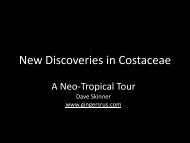BULLETIN - Heliconia Society International
BULLETIN - Heliconia Society International
BULLETIN - Heliconia Society International
You also want an ePaper? Increase the reach of your titles
YUMPU automatically turns print PDFs into web optimized ePapers that Google loves.
PAGE 2 THE <strong>BULLETIN</strong> / MAY 2009<br />
Xishuangbanna<br />
The Xishuangbanna Dai Autonomous Prefecture is<br />
located in the south-western tip of Yunnan province on<br />
the northern edge of the tropical zone, in south-western<br />
China. It is situated along the upper Mekong River, contiguous<br />
to Myanmar (Burma) and Laos. The climate of<br />
Xishuangbanna is dominated by southwest monsoons<br />
with heavy rainfall from May to October and a<br />
dry season from November to April. The<br />
plains and river valleys with an elevation of<br />
less than 800 meters have a tropical monsoon<br />
climate and those places with an elevation of<br />
over 800 meters have a subtropical monsoon<br />
climate. The annual mean temperature of the<br />
whole prefecture is 21° Celsius. It is usually<br />
free of frost all year round, but records of frost<br />
indicate temperatures of – 2° Celsius occurring<br />
every 25 years at elevations below 800 m,<br />
and regular short periods of frost at altitudes<br />
above. The yearly rainfall ranges from 1200 to 1900<br />
mm. In comparison with typical rainforest zones,<br />
Xishuangbanna is cooler in the dry season, and has<br />
lower rainfall, but there are 100 foggy days which increase<br />
air humidity and compensate for the shortage of<br />
rainfall. The tropical rainforest of Xishuangbanna provides<br />
favorable and extremely rich environments for<br />
flora and fauna.<br />
hotel in downtown Shanghai. The next morning I flew<br />
via Kunming to Jinghong, Yunnan. Upon arrival I met<br />
my first host Dr. Josef Margraf and his wife Minguo. I<br />
was accommodated for the next two weeks in their<br />
home with my own lodge, in which I had good research<br />
facilities to conduct measurements on my collected banana<br />
samples. Their three hectare (7½ acre) property is<br />
located on the bank of the Mekong River and has a<br />
Above, left to right:<br />
Dr. Josef Margraf,<br />
Minguo’s father, Mrs.<br />
Li Minguo-Margraf.<br />
Upper right: TianZi<br />
Biodiversity Centre<br />
Garden.<br />
Lower right: A TianZi<br />
office building.<br />
Travel to China<br />
I left my home on July 11 th , bound to the Helsinki<br />
airport from which I flew to Shanghai, China, where I<br />
arrived the next morning at the new Pudong international<br />
airport. As my connecting flight departed from the Hong<br />
Qiao domestic airport, which is located some 70 km from<br />
the international airport, I decided to stay overnight in a<br />
The Purpose of HSI<br />
The purpose of HSI is to increase the enjoyment and<br />
understanding of <strong>Heliconia</strong> (<strong>Heliconia</strong>ceae) and related plants<br />
(members of the Cannaceae, Costaceae, Lowiaceae,<br />
Marantaceae, Musaceae, Strelitziaceae, and Zingiberaceae) of<br />
the order Zingerberales through education, research and<br />
communication. Interest in Zingiberales and information on the<br />
cultivation and botany of these plants is rapidly increasing. HSI<br />
will centralize this information and distribute it to members.<br />
The HELICONIA SOCIETY INTERNATIONAL, a<br />
nonprofit corporation, was formed in 1985 because of rapidly<br />
developing interest around the world in these exotic plants and<br />
their close relatives. We are composed of dues-paying<br />
members. Our officers and all participants are volunteers.<br />
Everyone is welcome to join and participate. HSI conducts a<br />
Biennial Meeting and <strong>International</strong> Conference.<br />
Membership dues are (in $US): Individual, $35; Family,<br />
$40; Student, $10; Contributing, $50; Corporate (Company or<br />
Institution) $100; Sustaining, $500; Libraries, $25.<br />
Membership fees constitute annual dues from 1 July through 30<br />
huge jungle-like tropical garden. There are some ten<br />
Thai style wooden buildings on the property, some of<br />
which are fairly large. Many of the buildings accommodate<br />
German PhD students and researchers who<br />
are conducting their studies in Yunnan. I could not<br />
ascertain the total number of people who work at<br />
TianZi, as they have so many projects going on in the<br />
June. All members receive the <strong>BULLETIN</strong> (usually published<br />
quarterly), the Membership Directory, and special<br />
announcements. Please send all inquiries regarding<br />
membership or Bulletin purchases to: Ray Baker, Lyon Arboretum,<br />
3860 Manoa Road, Honolulu, HI 96822, Phone (808) 988-<br />
0455, Fax (808) 988-0462, raymondb@hawaii.edu. Back issues<br />
of the Bulletin are $5.00 per issue.<br />
HSI Officers for 2008-2009<br />
President, Anders J. Lindstrom; Vice-presidents for<br />
Membership, Carla Black and Jan Hintze; Secretary, (not<br />
filled); Treasurer, David Lorence; Editors, Ray Baker and<br />
Victor Lee; Cultivar Registrar, Bryan Brunner; Archivist: Sandra<br />
Barnes. Board of Directors: Mark Friedrich, Raymond<br />
Jerome, David Orr, David Skinner, Chelsea Specht.<br />
The HSI <strong>BULLETIN</strong> is the quarterly publication of the<br />
HELICONIA SOCIETY INTERNATIONAL. Editors: Raymond<br />
F. Baker, c/o Lyon Arboretum, 3860 Manoa Road,<br />
Honolulu, HI 96822 USA, 808-988-0455, 808-988-0462<br />
(FAX), raymondb@hawaii.edu and Victor Lee, 55 Jalan Kemuning,<br />
Singapore 769777, hortvet@singnet.com.sg , 65-<br />
67598208, 65-67571231 (FAX).


